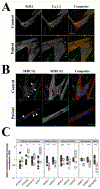Aberrant regulation of epigenetic modifiers contributes to the pathogenesis in patients with selenoprotein N-related myopathies
- PMID: 30932294
- PMCID: PMC6660981
- DOI: 10.1002/humu.23745
Aberrant regulation of epigenetic modifiers contributes to the pathogenesis in patients with selenoprotein N-related myopathies
Abstract
Congenital myopathies are early onset, slowly progressive neuromuscular disorders of variable severity. They are genetically and phenotypically heterogeneous and caused by pathogenic variants in several genes. Multi-minicore Disease, one of the more common congenital myopathies, is frequently caused by recessive variants in either SELENON, encoding the endoplasmic reticulum glycoprotein selenoprotein N or RYR1, encoding a protein involved in calcium homeostasis and excitation-contraction coupling. The mechanism by which recessive SELENON variants cause Multiminicore disease (MmD) is unclear. Here, we extensively investigated muscle physiological, biochemical and epigenetic modifications, including DNA methylation, histone modification, and noncoding RNA expression, to understand the pathomechanism of MmD. We identified biochemical changes that are common in patients harboring recessive RYR1 and SELENON variants, including depletion of transcripts encoding proteins involved in skeletal muscle calcium homeostasis, increased levels of Class II histone deacetylases (HDACs) and DNA methyltransferases. CpG methylation analysis of genomic DNA of patients with RYR1 and SELENON variants identified >3,500 common aberrantly methylated genes, many of which are involved in calcium signaling. These results provide the proof of concept for the potential use of drugs targeting HDACs and DNA methyltransferases to treat patients with specific forms of congenital myopathies.
Keywords: congenital myopathies; epigenetics; excitation-contraction coupling; gene expression; ryanodine receptor.
© 2019 Wiley Periodicals, Inc.
Conflict of interest statement
Figures




References
Publication types
MeSH terms
Substances
Grants and funding
- M.U.R.S.T/International
- USA/NIH Clinical Center/International
- NeRAB/International
- R01 AR044345/AR/NIAMS NIH HHS/United States
- OPO-Stiftung/International
- FSRMM/International
- WT_/Wellcome Trust/United Kingdom
- Fondazione Malattie Miotoniche/International
- U54 NS053672/NS/NINDS NIH HHS/United States
- SNF 31003A-169316/Schweizerischer Nationalfonds zur Förderung der Wissenschaftlichen Forschung/International
- P50 NS053672/NS/NINDS NIH HHS/United States
- MDA383249/Muscular Dystrophy Association/International
- SNSF_/Swiss National Science Foundation/Switzerland
LinkOut - more resources
Full Text Sources
Other Literature Sources
Medical
Molecular Biology Databases

